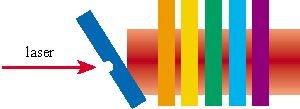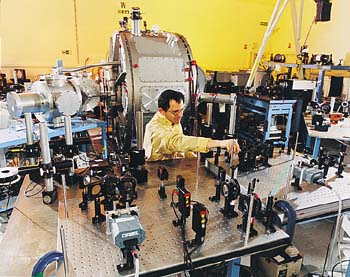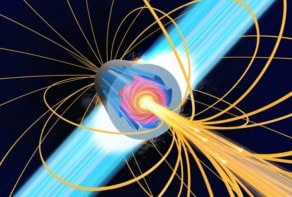Short high-intensity laser pulses can be used to initiate a variety of nuclear processes, ranging from fission to the emission of neutrons, protons and positrons.

About 20 years ago Toshi Tajima and John Dawson, then at the University of California at Los Angeles, suggested that laser-produced plasmas could be used to accelerate particles to high energies. The essential feature of their proposal was that the electrons would be accelerated by plasma waves moving at close to the speed of light in much the same way that a surfer is carried along by a wave, a fitting analogy for an idea originating in California. Since the accelerating field in the plasma wave can, in principle, be very much larger than that in a conventional accelerator, plasma-based acceleration has been investigated as an alternative to conventional high-energy techniques.
While the generation of ultrahigh-energy particles by this means is still a long way off, recent experiments at the Rutherford Appleton Laboratory (RAL) in the UK and at the Lawrence Livermore National Laboratory in the US have shown that lasers can be used to induce nuclear reactions (K Ledingham et al. 2000 Phys. Rev. Lett. 84 899; M Roth et al. www.llnl.gov/tid/lof/documents/pdf/236601.pdf; T E Cowan et al. 2000 Phys. Rev. Lett. 84 903). These demonstrations have been made possible by the technique of “chirped pulse amplification”. In this technique a short laser pulse is stretched in time before it is amplified, and then compressed again after amplification. Existing laser media cannot amplify very short pulses to high energies directly. Chirped pulse amplification has made it possible for fairly modest tabletop lasers to deliver terawatt (1012 W) power in sub-picosecond pulses, while the most powerful laser systems are approaching the petawatt (1015 W) range.
When focused onto a target, a terawatt laser is able to achieve intensities of 1019-1020 watts per square centimetre. At such intensities the “quiver motion” of an electron in the oscillating electric field of the laser is highly relativistic. The interaction of the laser with a solid target – which rapidly forms a plasma of positively charged ions and electrons – is a complicated nonlinear process that results in the plasma waves that accelerate the electrons to high energies.
The nuclear-physics experiments at the Rutherford lab were performed by a team led by Ken Ledingham from Glasgow University, collaborating with groups led by Peter Norreys from RAL and Bucker Dangor from Imperial College in London (Contemporary Physics 1999 40 367-383). The team irradiated a tantalum target with the VULCAN laser, which formed a plasma at the front of the target. High-energy electrons from the plasma were then slowed down by the back of the target, and released their energy as bremsstrahlung radiation. These gamma-ray photons were then used to initiate a series of photo-nuclear reactions in a secondary target made of layers of different materials (see figure 1).
A variety of reactions in which the gamma-ray photons eject neutrons from the atoms in the secondary target were observed, with the unstable nuclei that were formed being identified from their decay properties and half-lives. The threshold for ejecting neutrons from the secondary target ranged from about 7.6 MeV for tantalum to 18.7 MeV for the carbon layer. The fact that these reactions take place provides unequivocal evidence that photons with these energies are being produced in the primary target and this, in turn, indicates that electrons of a similar energy are being generated in the focal spot of the laser.
The electron temperature is a crucial piece of information if we want to understand the laser-plasma interaction, and compare experiment with theory and computer simulations. The electron temperature can be obtained from the relative degrees of activation in the copper and carbon layers in the secondary target. This new approach to the difficult task of measuring the electron temperature provides a useful addition to existing laser-plasma diagnostics.
The RAL team, and independently a group at Livermore led by Tom Cowan, also saw optically induced fission for the first time, verifying a theoretical prediction made more than ten years ago (K Boyer, T Luc and C Rhodes 1988 Phys. Rev. Lett. 60 557). In this process a gamma-ray has enough energy to split a heavy nucleus into smaller fragments. The target for these experiments was a 2 mm thick slab of uranium-238, which was irradiated with three consecutive laser shots with intensities of around 1019 W cm-2. The occurrence of fission was confirmed by the detection of gamma-rays with energies characteristic of iodine-134, cesium-138, strontium-92 and other fission fragments. The team estimated that each laser shot produced around 106 fission events.
Now that lasers are capable of initiating nuclear reactions, we may ask what applications this might have. In particular, could this approach provide a compact and economical source of short-lived radioactive isotopes for medical applications? At present the yield per shot is too low and an impossibly large number of laser shots would be needed to produce a useful amount of an isotope. However, theory suggests that as the laser intensity is increased to around 1020 W cm-2, the efficiency for the conversion of laser power into fast electrons, and hence into gamma-rays, is increased. If laser technology continues to advance at its current rate, then we can envisage compact lasers delivering about 1 J of energy in pulses of less than 100 fs at a repetition rate of around 10 pulses per second. Such a laser could produce a useful amount of an isotope in about a day at a commercially viable cost.
The Glasgow-Rutherford-Imperial collaboration has just received funding to investigate the commercial potential of producing proton beams with the ASTRA laser (~1019 W cm-2) at RAL. The protons will be produced from the interaction of the laser light with a thin plastic layer. Such proton beams could be used to produce short-lived positron emitters for use in positron emission tomography. This is a powerful medical diagnostic technique but its use is limited at present because the positron-emitting isotopes required can only be produced by cyclotrons or van de Graaff accelerators.
High-energy ions are also generated in the focal spot of the laser and these have the potential to trigger fission reactions in heavy-element targets. In general, the use of very short laser pulses will open up the sub-nanosecond regime in nuclear physics, and will also permit the investigation of ultra-short-lived isotopes far from stability.
At even higher intensities still, around 1021 W cm-2 and above, other processes are predicted to occur. Electron-positron pair production, which has already been seen at Livermore (Physics World May 1999 p5), has the potential to provide useful positron-beam sources. And at such high laser intensities, the photon spectrum is expected to extend to high enough energies (above 140 MeV) to give a measurable output of pions.
The team working at RAL has done much to pioneer the application of lasers to nuclear processes, and as VULCAN is upgraded to higher intensities over the next two years, further exciting developments in this field can be anticipated.



